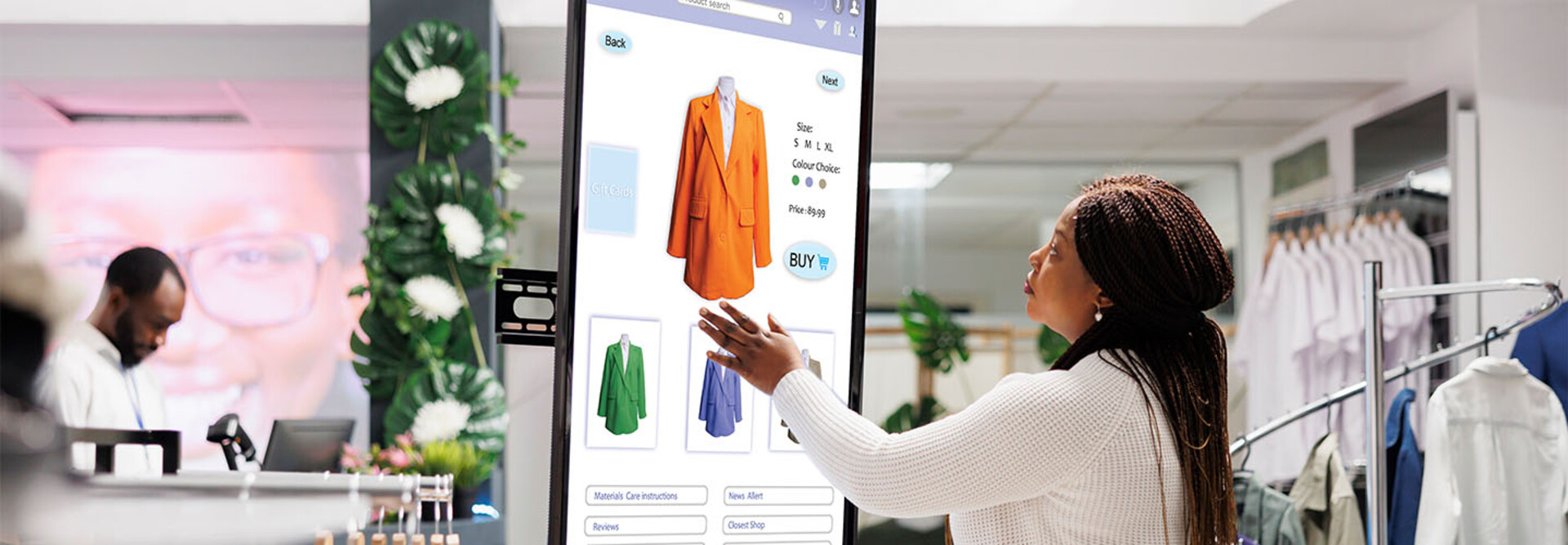Shoppers have high expectations when it comes to in-store experiences. And experts say the “power of in-store fulfillment” is real, incentivizing shoppers to return again and again. “Customers want more of a dynamic experience,” says Rich Borkowski, principal industry architect at CDW. “They want more information readily available at their fingertips, like they have when they shop online.”
To go the extra mile for their customers, retailers are leveraging the latest set of digital signage solutions to create colorful, sensory and surprising in-store moments.
Here’s a snapshot of some of the most successful digital signage solutions on the market now:
EXPLORE: How CDW’s digital signage solutions can help your brand.
“Lift and Learn” Digital Signage Raises the Bar for Retailers
Digital signage is commonly used for sharing general information, emergency messaging or advertising. But there’s a more sophisticated version of the technology at work in retail. It can intuit what customers want while they’re looking for it.
“Lift and learn” digital signage is one type Borkowski describes that uses radio-frequency identification and other smart sensors. Say a customer picks up a sneaker in a Foot Locker. A nearby sign senses the motion and automatically displays information about that shoe: its material and size, and a story of how it’s used on the basketball court — plus, how it can be purchased online.
Retailers who want to use this technique can place RFID tags on the bottom of products or place them on a smart shelf. This brings online details to the customer in-store.
Some stores are offering customers an enhanced experience when shopping for wine, Borkowski says. “If you’ve got an interactive display in a wine store, you could pick up a bottle of wine and find out what region of the country its grapes were grown in, what it pairs well with,” he adds. Suddenly browsing for your wine becomes a multifaceted experience.
One of the technologies at work in these scenarios is Zebra’s SmartLens. This overhead RFID sensor can be deployed at key points throughout a store; for instance, at the entry or exit, or at the point of sale.
RELATED: The hot technology retailers need to reduce in-store friction.
Endless Aisle Tech Adds Convenience for Customers
Retailers are also using digital signage to create “endless aisle” opportunities for customers in stores. This is a sales technique where in-store shoppers are presented with the option to purchase products currently unavailable in the store. Whether through a touch-screen kiosk or scannable QR code, shoppers can apply in-store deals to an online purchase — without having to talk to a store associate.
“Endless aisle adds convenience for customers because they can do all of this themselves,” Borkowski says. The approach also reduces labor costs and increases incremental sales. “Customers don’t have to wait, they can make their purchase instantly.”
ELO Touch Screens Simplify Store Checkout
ELO’s digital signage offerings are helping retailers ensure that checkout is frictionless.
“It’s a streamlined process for the consumer, no matter where they’re trying to check out,” Borkowski says. It guarantees continuity for shoppers, ensuring they can be self-reliant. “They don’t have to ask questions. They can do it on their own.”
ELO’s digital signage technology integrates seamlessly with retail point-of-sale systems, leveraging advanced touch screens and real-time data synchronization on the back end to enable faster transactions. The screens can also signal which aisles are open in real time (like a Trader Joe’s checkout process) to reduce waiting.
Samsung MagicINFO Provides Content Management Capabilities
Retailers that are unable to design content management displays in-house are turning to Samsung’s MagicINFO solutions. For example, Saatva, the luxury mattress retailer, created “viewing rooms” of their beds using Samsung's dual-sided OMN-D series displays and 13-inch QBR smart signage that runs through MagicINFO cloud. This setup allows customers to explore product features in 360-degree views of selected bedding and mattresses.
“Samsung’s MagicINFO gives a lot of opportunity to create immersive experiences that will resonate with shoppers and help products stand out from the competition,” says Borkowski.
KENZO fashion boutique uses Samsung's MagicINFO VideoWall software to synchronize high-impact video walls with interactive smart devices, transforming a static retail environment into an engaging experience.
54%
The percentage of customers who have stopped doing business with a company due to a poor personalized experience
Source: retailcustomerexperience.com, “More consumers want better customer experience,” Feb. 21, 2023
Nexmosphere and Mood Media Signal Sounds and Smell in Stores
Some department stores are using Nexmosphere's RFID and lidar sensors to detect when a customer picks up a product at a skincare or cosmetic counter. This action triggers a display of detailed information about the item, including benefits and promotional content. Such an interactive approach has been shown to increase sales by 15% to 30%. Museums are also using X-Eye Presence sensors to detect when a visitor approaches a display and to maintain safe occupancy levels.
“It’s about all the senses: sight, sound and smell,” adds Borkowski. “Mood Media is a great partner to really get all your senses going.”
With Mood Media’s Harmony platform, retailers can curate a playlist based on the setup of their store. Say a customer is browsing the swimwear section: Cue the pool party hits. Passing by a set of Christmas trees and ornaments? Holiday music can set the mood. Retailers have found this not only encourages customers to stay in stores longer but also helps employees.
Hotels have partnered with Mood Media to create inviting atmospheres in their lobbies and guest rooms. The company offers over 2,400 fragrances — each meant to inspire a positive feeling. Lavender and vanilla, for example, are associated with calm, relaxation and tranquility.
Customer desires are the driving force behind this new set of digital signage solutions. Research shows that 80% of shoppers are prepared to spend more for premium environments. That’s why enhancing the overall shopping experience is a must for retailers.













